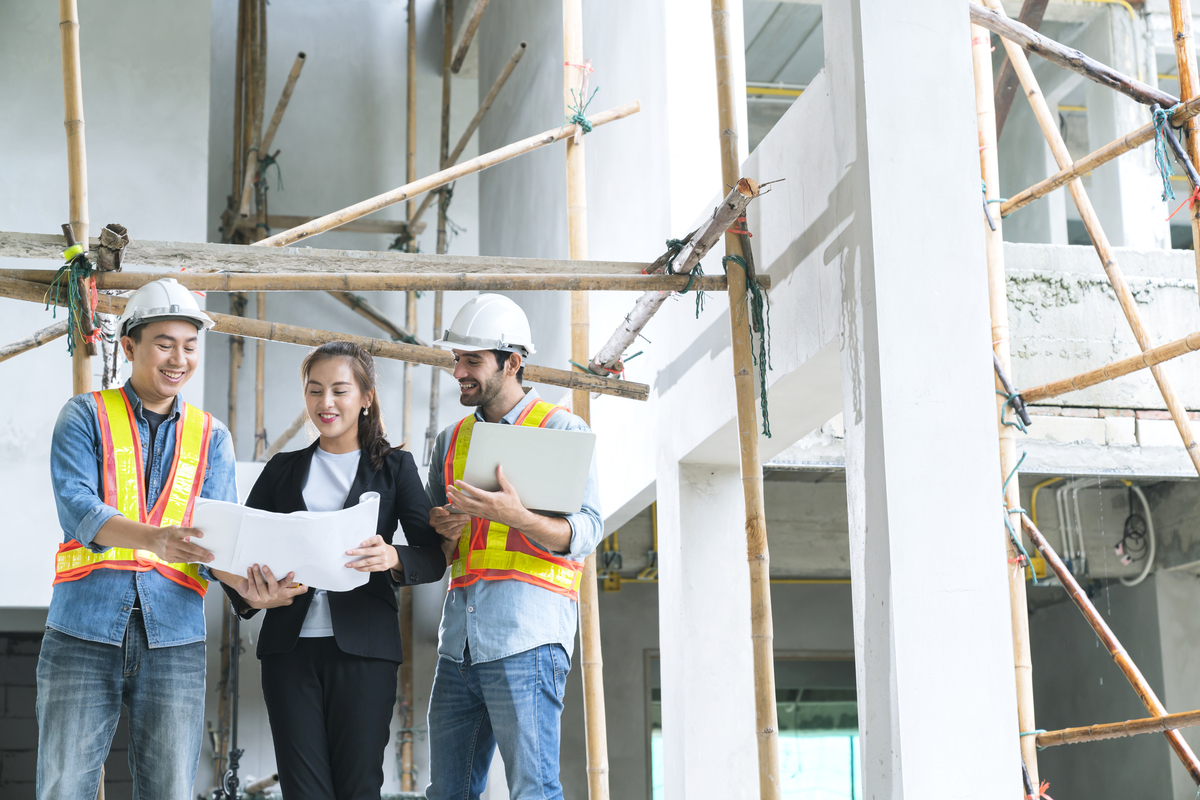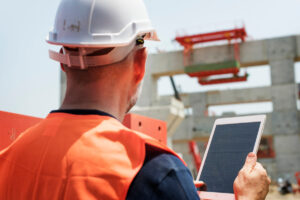Updated by Nazanin Ghodsian, 05/01/2025
A key component of managing construction projects is construction monitoring, which guarantees that they are finished to the highest safety and quality standards, on schedule, and within budget. Regular inspections and thorough documentation of each stage of the project, from safety and progress to quality assurance and regulatory compliance, are part of this continuous process.
By leveraging tools like drones in construction, Building Information Modeling (BIM), and sophisticated software solutions, construction monitoring enhances efficiency and precision. This article delves into the techniques and tools that revolutionize construction monitoring, underscoring its critical role in mitigating risks, enhancing safety, and delivering high-quality construction projects on time and within budget.
Table of Contents
Overview of Construction Monitoring
Construction monitoring is a systematic process that involves regular inspection and documentation of various aspects of a construction project to ensure that it adheres to the established plans, specifications, and regulatory requirements. It encompasses the continuous observation, measurement, and assessment of the project’s progress, quality, safety, and compliance.
Components of Construction Monitoring:
- Scheduling: Tracking project timelines to ensure milestones are met and the project stays on schedule.
- Quality Control: Verifying that materials, workmanship, and procedures meet the required standards and specifications.
- Construction Budget Management: Monitoring expenses to ensure the project remains within the allocated budget and identifying potential cost overruns early.
- Safety Inspections: Ensuring that all safety protocols are followed to prevent accidents and injuries on the construction site.
- Compliance Checks: Ensuring adherence to local, state, and federal regulations, as well as industry standards and contractual obligations.
- Progress Reporting: Regularly documenting and reporting on the project’s status to stakeholders, including updates on any issues or changes.
Purpose and Importance: Construction monitoring plays a crucial role in the successful delivery of construction projects by:
- Ensuring Quality: By maintaining high standards, construction monitoring helps prevent defects and ensures the longevity and reliability of the built structure.
- Controlling Costs: Continuous oversight helps in identifying and mitigating financial risks, thereby preventing budget overruns.
- Adhering to Schedules: Regular monitoring helps in keeping the project on track, ensuring timely completion and avoiding delays.
- Enhancing Safety: Consistent safety checks reduce the risk of workplace accidents, ensuring a safer environment for all workers.
- Ensuring Compliance: By adhering to regulatory and contractual requirements, construction monitoring helps avoid legal issues and potential fines.
- Risk Management: Early identification of potential problems allows for proactive measures, reducing the likelihood of project disruptions.
Overall, construction monitoring is an indispensable practice that ensures that construction projects are executed efficiently, safely, and within the predetermined scope, budget, and timeline.

Benefits of Construction Monitoring
Improved Security Against Theft and Damage: Construction site security is essential to prevent vandalism and unauthorized access to equipment, data, or designated work zones. Implementing surveillance cameras, access control systems, location tracking, IoT sensors, and other monitoring technologies deters criminals from targeting your site. Should any theft or damage occur, these systems provide crucial evidence and allow for swift intervention.
Suggested article to read: Data Security in Construction Data Management | Cybersecurity in Construction
Comprehensive Documentation for Injuries and Accidents: Construction sites are inherently risky, and accidents can happen. Monitoring systems, such as video cameras and wearable sensors, document incidents, providing valuable evidence for investigating accidents, understanding their causes, and resolving related claims or disputes.
Cost Reduction: Monitoring resource utilization, including labor, equipment, and materials, helps project managers identify inefficiencies and optimize allocation, leading to reduced costs. Early detection and resolution of issues minimize the need for rework and avoid potential delays or penalties, further cutting project expenses.
Increased Efficiency Across the Site: Real-time visibility into site activities, progress, and resource utilization through construction site monitoring enhances efficiency. This enables better coordination, optimized workflows, and proactive decision-making. By promptly identifying bottlenecks, issues, or deviations from the plan, construction companies can take corrective actions, streamline operations, and ensure smooth project execution.
Suggested article to read: How to Reduce Construction Cost

Techniques and Tools for Effective Monitoring
To ensure the success of a construction project, implementing a robust monitoring strategy is essential. Effective monitoring involves a combination of traditional methods and cutting-edge technologies that work together to provide comprehensive oversight. By integrating these diverse techniques, project managers can maintain tight control over every aspect of the project, from scheduling and budgeting to quality assurance and safety compliance. The following sections explore the modern technologies and tools that have revolutionized construction monitoring, offering enhanced precision, efficiency, and reliability in managing complex construction projects.
Modern Technologies:
- Drones in Construction:
- Aerial Surveys: Drones provide high-resolution aerial imagery and video footage, offering a comprehensive view of the construction site.
- Progress Tracking: Regular drone flights can document progress and detect discrepancies between the actual and planned construction.
- Safety Inspections: Drones can access hard-to-reach areas, enhancing safety by reducing the need for manual inspections in hazardous locations.
- Building Information Modeling (BIM):
- 3D Modeling: BIM creates detailed 3D models of the project, integrating data from various sources to provide a unified view.
- Collaboration: Facilitates collaboration among stakeholders by offering a centralized platform for sharing and updating project information.
- Clash Detection: Identifies potential conflicts in design elements before construction begins, preventing costly rework.
Software Solutions:
- Project Management Software:
- Task Scheduling: Tools like Microsoft Project and Primavera help in planning, scheduling, and assigning tasks.
- Resource Allocation: Efficiently manage resources, ensuring that materials and labor are available when needed.
- Real-Time Updates: Provides real-time updates on project status, enabling prompt decision-making.
- Construction Management Software:
- Procore: Offers features for document management, quality and safety inspections, and communication among teams.
- Autodesk Construction Cloud: Integrates workflows across all phases of construction, from design to handover, enhancing coordination and transparency.
- Buildertrend: Focuses on residential construction with tools for project scheduling, budgeting, and client communication.
Data Analytics:
- Performance Metrics:
- Key Performance Indicators (KPIs): Track construction KPIs such as schedule adherence, budget compliance, and quality metrics to gauge project performance.
- Predictive Analytics: Use historical data to predict future trends, identify potential risks, and develop mitigation strategies.
- Dashboards and Reporting:
- Custom Dashboards: Create customizable dashboards to visualize data in real-time, providing insights into project health.
- Automated Reporting: Generate regular reports on various aspects of the project, ensuring stakeholders are kept informed.
Manual Techniques:
- Regular Site Inspections:
- Checklists: Use detailed checklists to ensure all aspects of the construction are inspected thoroughly.
- Daily Logs: Maintain daily logs of activities, issues, and progress, providing a comprehensive record of the project’s evolution.
- Meetings and Communication:
- Regular Meetings: Hold regular meetings with project teams to review progress, address issues, and plan next steps.
- Stakeholder Communication: Ensure clear and consistent communication with all stakeholders to keep them informed and involved.
Emerging Technologies:
- Internet of Things (IoT):
- Sensors: Use IoT sensors to monitor various parameters such as temperature, humidity, and structural integrity in real-time.
- Connected Equipment: Track the location and usage of construction equipment, optimizing utilization and maintenance.
- Artificial Intelligence (AI):
- Predictive Maintenance: AI algorithms can predict when equipment is likely to fail, allowing for preemptive maintenance.
- Risk Management: AI can analyze vast amounts of data to identify potential risks and suggest mitigation measures.
Overall, these techniques and tools are essential for effective construction monitoring, ensuring that projects are completed on time, within budget, and to the highest standards of quality and safety.

Why Many Infrastructure Projects in Developing Countries Fail
Many infrastructure projects in developing countries face significant challenges and often fail to meet their goals. The main reasons for these failures are poor planning and inadequate monitoring and evaluation.
Effective planning is crucial for the success of any project. According to the International Union for Conservation of Nature (IUCN), projects that are not well-planned are difficult to monitor and evaluate effectively. Moreover, even a well-planned project cannot achieve its desired outcomes without proper monitoring and evaluation.
For projects to be successful, they need to be carefully planned and continuously monitored. This ensures that they create job opportunities, provide essential health, education, and economic infrastructure, satisfy stakeholders, deliver value for money, and achieve high-quality standards.
Conclusion
Construction monitoring is vital for the success of construction projects, providing a structured approach to oversee and manage various aspects such as scheduling, quality, budget, safety, and compliance. By incorporating modern technologies like drones, BIM, and IoT, as well as effective software solutions and data analytics, project managers can achieve precise, efficient, and reliable oversight.
This comprehensive monitoring not only ensures adherence to plans and regulations but also enhances safety, controls costs, and mitigates risks. Ultimately, robust construction monitoring practices are indispensable for delivering high-quality projects on time and within budget, ensuring long-term reliability and stakeholder satisfaction.
FAQs
What is Construction Monitoring?
- Answer: The ongoing examination and recording of a project’s status, quality, safety, and adherence to guidelines and plans is known as construction monitoring. It guarantees that projects be finished effectively, safely, and economically.
Why is Construction Monitoring Important?
- Answer: Ensuring quality, managing expenses, meeting deadlines, improving safety, and guaranteeing regulatory compliance all depend on construction monitoring. It assists in avoiding errors, overspending, delays, and legal problems.
What are the Key Components of Construction Monitoring?
- Answer: Scheduling, budget management, quality control, safety inspections, compliance checks, and progress reporting are important elements. Together, these components guarantee that the project stays on course.
How do Modern Technologies Improve Construction Monitoring?
- Answer: Drones, BIM, and construction management software are a few examples of technologies that improve monitoring by giving real-time data, increasing accuracy, and facilitating better decision-making throughout the project.
What Role does Data Analytics Play in Construction Monitoring?
- Answer: Key performance indicators (KPIs), risk assessment, and automated report generation are all aided by data analytics. This makes proactive management possible and updates stakeholders on the status of the project.
Suggested article for reading:
7 Innovative Construction Robotics Changing the Industry
Digital Transformation: The Role of 5G Technology in Construction
12 Cutting-Edge Technologies in Construction Automation You Need to Know
Industrial Internet of Things (IIoT) Guide to 2025
11 Best IoT Consulting Services Providers in 2025
Resources:
Cloud front | Simon IoT | Buiding Performance | Palmerston City Council
For all the pictures: Freepik





